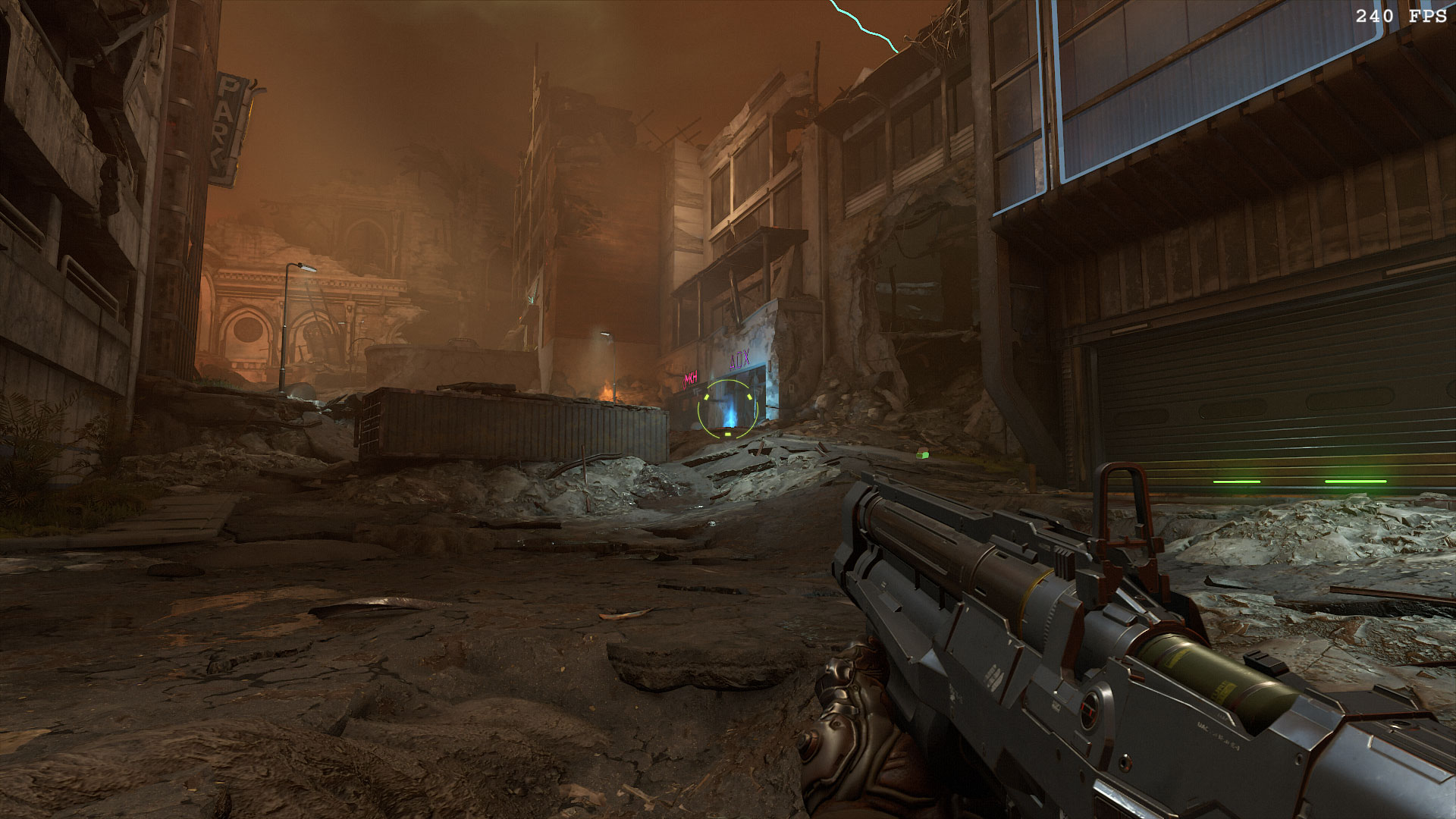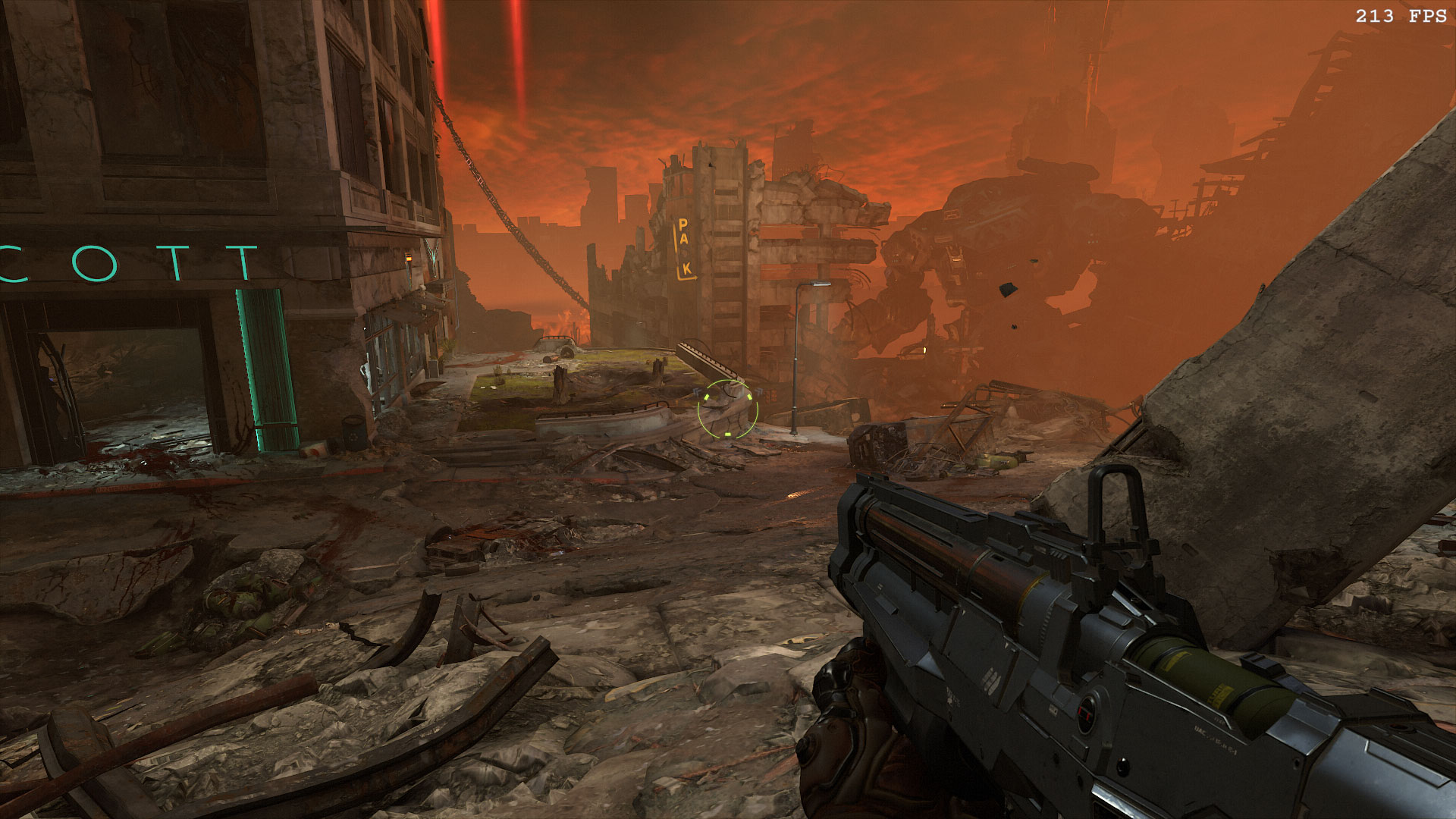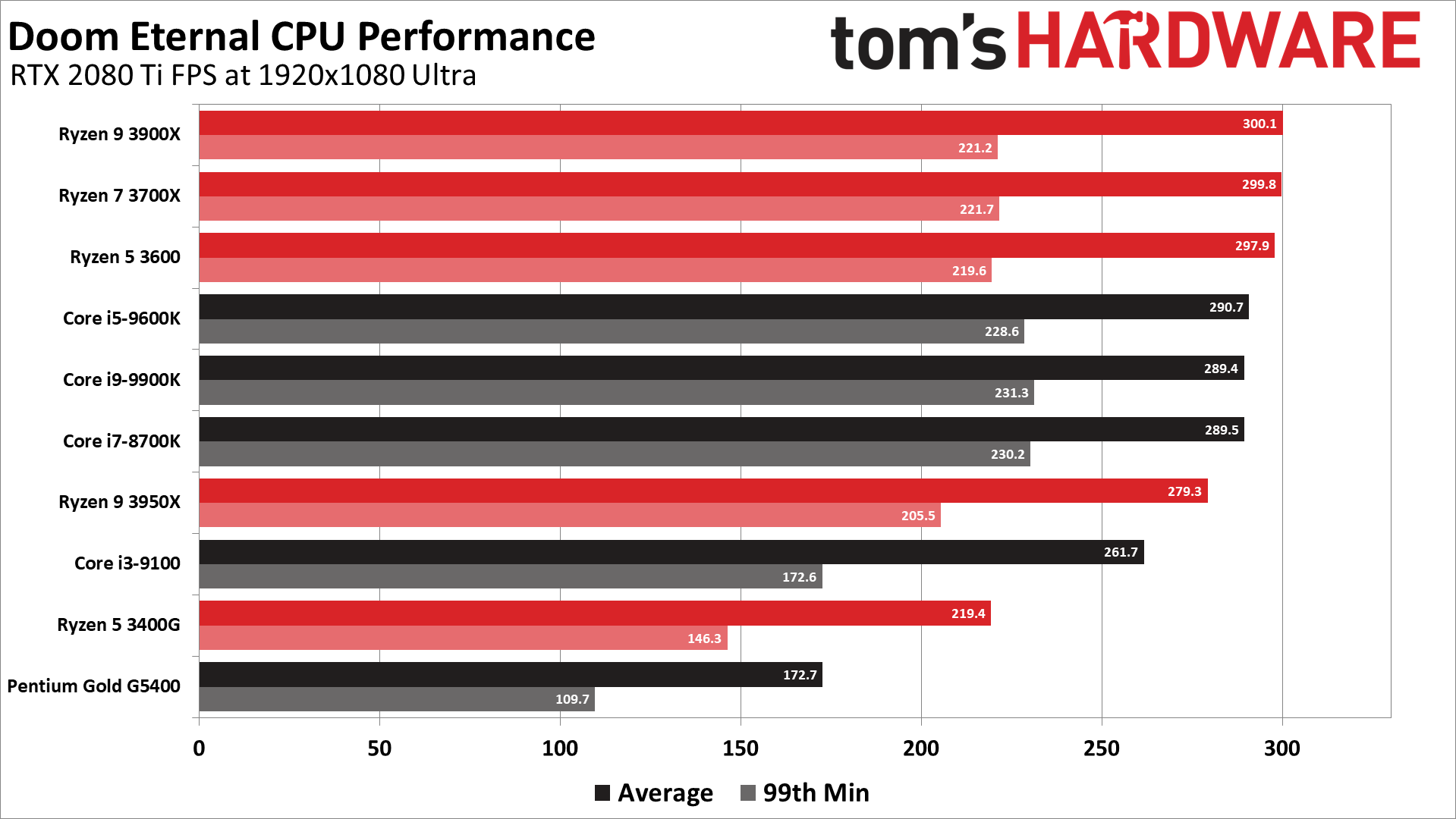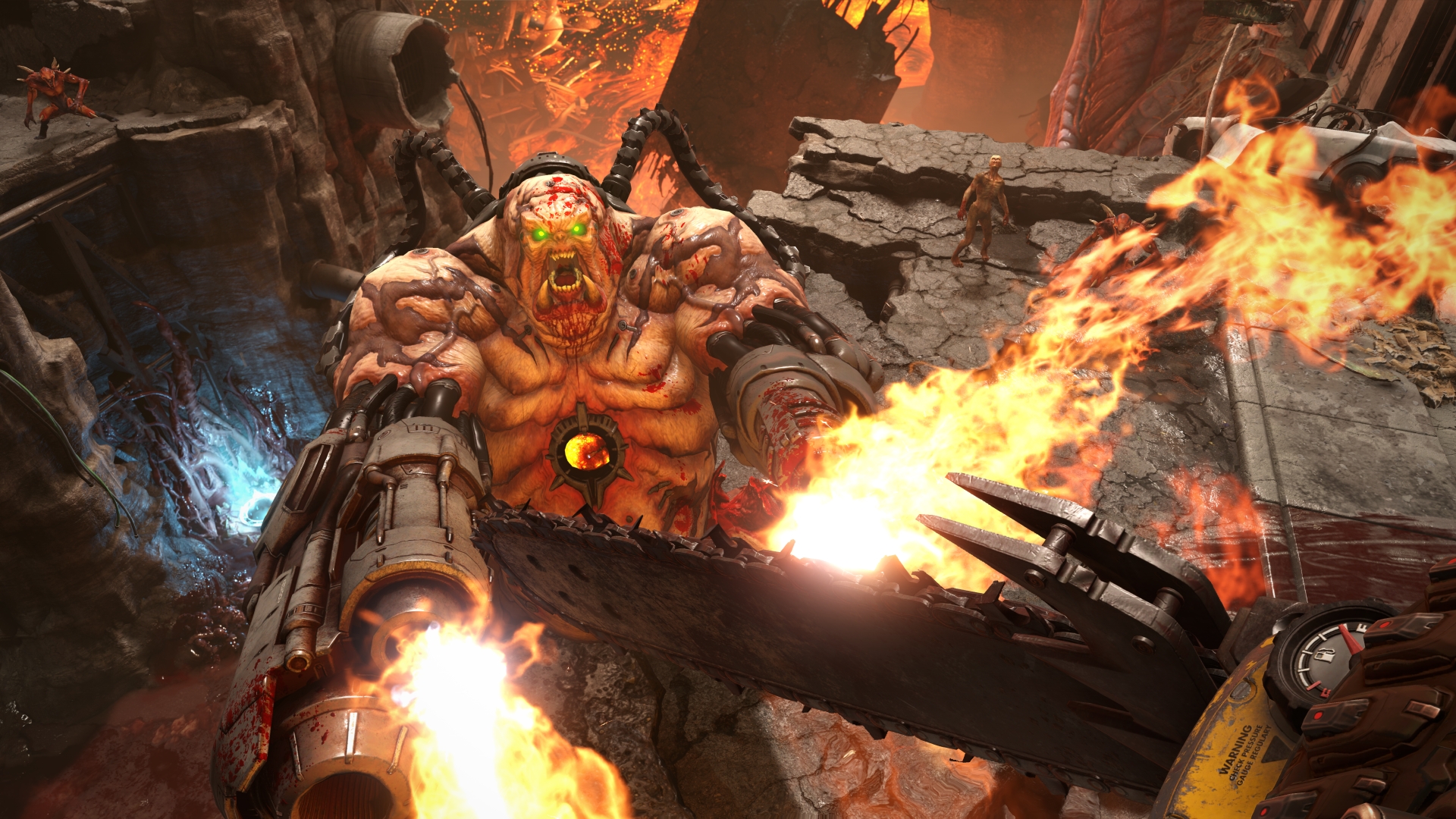Doom Eternal Graphics, CPU Testing: id Shows How to Optimize for Performance
We tested Doom Eternal on 20 GPUs and 10 CPUs to find out what you need to hit 60 fps or more.
Doom Eternal released on March 20, and we've been testing performance across a large collection of GPUs and CPUs to see how well it runs, along with what settings have the biggest effect on performance. Any of the best graphics cards should easily handle Doom Eternal, and the best CPUs for gaming are proving equally capable. But what about cards further down the GPU hierarchy, or processors that aren't at the top of the CPU Benchmark hierarchy? We're doing our best to cover the full gamut, and here's what we've found.
First, your GPU probably won't be a problem unless it's very old and/or slow. Even a GTX 1050 managed a respectable 55 fps at 1080p low—and that's at full resolution, with none of the resolution scaling nonsense integrated graphics has to sometimes use. You can check our guide to getting Doom Eternal running on integrated graphics for more details if you're running a potato PC. The bigger issue for a lot of moderately old graphics cards is going to be the VRAM requirements.
Doom Eternal needs 2942 MiB of VRAM to do 1080p with its low preset. It will still run on a 2GB card like the GTX 1050, even though it doesn't have the requisite 3GB of VRAM, but you can't even try bumping most settings higher. If you want to run at 1080p medium, you'll need a card with 4GB or more VRAM (3502 MiB to be precise), while 1080p high also comes in just under the 4GB barrier at 4078 MiB. Ultra needs 5230 MiB at 1080p, 5437 MiB at 1440p and 6025 MiB at 4K—so at least 6GB of VRAM. Nightmare pushes just beyond 6GB, to 6254 MiB, and ultra nightmare needs 6766 MiB at 1080p—an 8GB GPU will suffice in either case, at resolutions up to 4K.
The good news: If you have the VRAM, many recent GPUs can handle Doom Eternal at 4K, even with maxed out settings. The Radeon RX 5700 and RTX 2060 Super and above all managed to break 60 fps at 4K ultra nightmare.
What about the CPU? Sure, top performance will come with higher clocks and more cores or threads, at least up to a certain point. But the CPU demands appear quite tame. Everything from the Core i5-9600K or Ryzen 5 3600 and above managed to max out framerates on an RTX 2080 Ti—and lower performance GPUs would be fine with a far slower CPU. Hell's fury will even run fine on a paltry 2-core/4-thread Pentium Gold G5400 CPU if that's all you have available, assuming your GPU is up to snuff.
Test Setup
Our testbed for Doom Eternal is the same as our normal graphics card setup—it has a Core i9-9900K processor, 32GB of DDR4-3200 memory, and a 2TB NVMe SSD. We've got a collection of 20 GPUs (not counting the failed attempt to run Doom Eternal on Intel integrated graphics), and we tested the RTX 2080 Ti on a bunch of CPUs as well. We've tested each graphics card starting at 1080p low, with resolution scaling set to off. Then we've tested at 1080p medium and ultra, 1440p ultra, and 4K ultra and ultra nightmare—assuming the GPU had enough VRAM. Only GPUs with 8GB VRAM could run 4K ultra nightmare, so we only have 11 GPUs on that chart.
For CPU testing, on the Intel side we use the same system with other Coffee Lake Intel CPUs: Core i7-8700K, Core i5-9600K, Core i3-9100, and just for good measure we've trotted out a Pentium Gold G5400. This should give us a reasonable idea of how a game scales (or doesn't) with more cores, threads, and/or clockspeed. The AMD CPU testbed is mostly the same, except for the CPUs and motherboard. We've tested recent AMD chips, including the Ryzen 9 3950X, Ryzen 9 3900X, Ryzen 7 3700X, Ryzen 5 3600, and Ryzen 5 3400G.
Get Tom's Hardware's best news and in-depth reviews, straight to your inbox.
Our GPUs include a limited selection of the past several generations of hardware from AMD and Nvidia. For Nvidia, we've tested all the Super GPUs—RTX 2080 Super, RTX 2070 Super, RTX 2060 Super, GTX 1660 Super and GTX 1650 Super—along with the RTX 2080 Ti. We used the Founders Edition model for each GPU where possible, with an EVGA 1660 Super and an MSI 1650 Super Gaming X. (Note that logistics prevented us from including the RTX 2060 at this time, but we'll be adding it soon.) From the previous generation, we also tested the GTX 1080 Ti FE, GTX 1060 6GB FE, and GTX 1050 (2GB MSI Gaming). Finally, the GTX 970 (Zotac with reference clocks) from the 900-series rounds out our collection of Nvidia cards. From AMD, we've tested all of the RX 5000 series GPUs. The 5700 XT and 5700 are reference cards, the 5600 XT and 5500 XT models are all Sapphire Pulse. For the previous generation, we have the Radeon VII (reference), Vega 56 (reference) and RX 570 4GB (MSI Gaming X). Last but not least, the R9 390 (Sapphire) says hello from 2015.
Our test sequence uses a portion of the first level of the game, with OCAT for logging frametimes. We run a set path that takes 70 seconds, after clearing the area of enemies (which just get in the way of repeatable testing). Each setting is tested at least twice, and three times at 1080p low (discarding the first run while the hardware 'heats up'). We then report the best result of the two remaining runs, and in general there's less than a 1% difference between the two runs.
Doom Eternal Graphics Card Performance
We've tested 20 different graphics cards, spanning the past six years of hardware. Obviously, that's not every GPU released, but it should allow you to interpolate most of the missing data points. For example, the GTX 1080 is about 15-20% slower than 1080 Ti, and the 1070 is another 15-20% drop from the 1080—or it's about 35-40% faster than the 1060 6GB. Similarly, the RX 580 8GB is about 20-25% faster than the RX 570, the 590 is 30-40% faster than the 570, and the Vega 64 is 6-7% faster than the Vega 56. It would be nice if time permitted testing of every GPU, but even just sticking to the past three years, that's at least 15 AMD GPUs and 24 Nvidia GPUs, with another 25 or so from the previous generation. Besides dedicated GPUs, we also tested the Vega 11 Graphics on a Ryzen 5 3400G, including results at 720p low, which turns out to be very playable.






Across all six setting and resolution combinations we tested, the RTX 2070 Super, 2080 Super, and 2080 Ti hold down the top three spots. That's not too surprising, as generally speaking AMD has no answer to anything above the level of the RTX 2070. What's noteworthy is that even at 1080p and minimum quality, Doom Eternal appears to be mostly GPU limited.
The next three slots vary a bit. Radeon VII and RX 5700 XT end up pretty evenly matched, with the Radeon VII performing better at 1080p low and medium, but the RX 5700 XT takes the lead at 1080p/1440p ultra, and then the Radeon VII is back on top at 4K testing. The RTX 2060 Super and GTX 1080 Ti are also a pretty close match, with the 2060 Super delivering better minimum framerates at 1080p and 1440p. The two Nvidia cards also jump ahead of the Radeon VII and RX 5700 at 1080p ultra, which otherwise ends up a bit faster overall, until it once again falls behind at 4K ultra nightmare.
GPU memory bandwidth is an important aspect of performance, which is clearly illustrated by looking at the RX 5700 and RX 5600 XT. Both have the same 2304 GPU cores, and the 5600 XT is even clocked a bit higher (because it's a Sapphire Pulse that's factory overclocked, including 14 Gbps GDDR6 memory). However, the RX 5700 has 8GB of VRAM on a 256-bit interface, compared to 6GB on a 192-bit interface, so the RX 5700 has 33% more memory bandwidth. The RX 5700 was 1% faster at 1080p low, 14% faster at 1080p medium, 23-24% faster at 1080p/1440p ultra, and 56% faster at 4k ultra—and of course the RX 5600 XT can't attempt to run ultra nightmare settings as they require too much VRAM.
A few other interesting bits of information from the charts. First, the GTX 1050 plugs along at 55 fps at 1080p low. It's definitely playable, and with a few tweaks like resolution scaling (see our running Doom Eternal on integrated graphics guide) it could easily break 60 fps. Short of console commands, however, you'll be restricted to low settings due to the 2GB VRAM. The Vega 11 Graphics integrated into the 3400G have no such limitation, because the game detects shared system memory as VRAM. Even though Vega 11 ends up being about 30% slower than the GTX 1050, it can run (or at least attempt to run) every setting at ultra nightmare.

Low

Medium

High

Ultra

Nightmare

Ultra Nightmare

Low

Medium

High

Ultra

Nightmare

Ultra Nightmare

Low

Medium

High

Ultra

Nightmare

Ultra Nightmare
As far as image quality goes, it's also surprising how good Doom Eternal looks even at low quality settings. In fact, looking at the above gallery, you'll note that from high quality onward, there's not really a major difference in visuals. Ultra nightmare may require twice the VRAM compared to the high setting, but it's at best a minor bump in image fidelity. (Also, don't pay too close attention to the framerate in the corner, as it fluctuates so an instantaneous screenshot isn't a valid benchmark.)
VRAM isn't just about what settings you can run either: Look at the 1080p medium chart, near the bottom, and contrast that with the 1080p low chart. The RX 570 4GB is quite a bit faster than the 1060 6GB and GTX 970 at low settings, but ends up barely ahead of the 970 at medium settings. The R9 390 meanwhile goes from tying the GTX 1060 6GB, to trailing at 1080p ultra, and then ends up with a sizeable lead by 1440p and 4K ultra.
That's not to say all is fine with AMD's older GCN architectures. The RX 5500 XT 8GB consistently beats the R9 390 and RX 570 cards, showing the improvements made in AMD's RDNA architecture. The same goes for Nvidia's Turing architecture. The old Pascal 1060 does okay, but the 1650 Super easily beats it at 1080p medium (before it runs out of VRAM), and the 1660 Super is over 50% faster at all tested resolutions and settings.
As far as settings go, assuming you have sufficient VRAM, there's not a massive difference in performance between the low, medium, high, ultra, nightmare, and ultra nightmare settings. Going from low to medium only drops performance on most cards by around 5%, and even the jump from low to ultra only drops performance about 20%. Assuming you have a card with 8GB or more, not even ultra nightmare is particularly punishing—it's only about 3-4% slower than ultra on most cards.
Finally for the GPUs, let's quickly list the minimum GPUs required for 60 fps and 144 fps at each setting. For 1080p low at 60 fps, just about any modern graphics card will suffice, with the GTX 1050 being the only exception we tested. (Older 700 series Nvidia and R7/R7 200 series AMD are likely in the same situation.) 1080p low and 144 fps is also in reach for most modern GPUs: the RX 5500 XT and above will suffice. Not much changes at the medium preset, except for 144 fps you'll now need the RX 5500 XT 8GB card or above. For 1080p ultra, all of the cards we tested break 60 fps, and the Vega 56 and above can do 144 fps. 1440p ultra starts to push the GPUs harder, and while the RX 5500 XT 8GB manages to stay above 60 fps, 144 fps will need at least a Radeon VII or RX 5700 XT. Lastly, 4K ultra at 60 fps needs an RTX 2060 Super or RX 5700 or faster GPU, and the same holds for 4K ultra nightmare. Nothing can do 144 fps at 4K ultra, but it's nice to see so many of the high-end GPUs still breaking 60 fps at maxed out settings.
Doom Eternal CPU Performance
Trying to test games on a large variety of CPUs is even more difficult than GPU testing, considering how many different platforms there have been in the past five years, never mind older PCs that are still running fine. Plus, unlike GPUs, swapping CPUs is far more involved: Remove the CPU cooler (a liquid cooling waterblock in this case), wipe off the thermal grease, carefully unlatch the CPU and place it in a protective clamshell, put in the next CPU, apply thermal paste, attach cooler, and then boot up the PC and go through the "Your CPU has changed" BIOS configuration process. To minimize headaches, we're only looking at the two most recent mainstream CPU platforms, Intel LGA1151 (with Z390 chipset) and AMD AM4 (with X570 chipset). However, we've used five CPUs spanning from the top to bottom performance options on each platform, which gives a wide view of what to expect.






As noted earlier, Doom Eternal ends up being extremely light with regards to CPU requirements. If all you want is 60 fps, every CPU we tried managed that with plenty of room to spare. Even a relatively pathetic Pentium Gold G5400 (2-core/4-thread CPU clocked at 3.7 GHz) averaged 180 fps with minimums of 115 fps at 1080p low. Meanwhile, the Core i5-9600K, Core i7-8700K, and Core i9-9900K were all tied across all resolutions and settings.
The AMD side of things is perhaps more interesting. The Ryzen 9 3950X was only slightly behind the faster Intel CPUs, except it appears to be a case of too many cores and threads for its own good. The Ryzen 9 3900X, Ryzen 7 3700X, and Ryzen 5 3600 were all better performers in Doom Eternal. Only the Ryzen 5 3400G, with its x8 PCIe link to the GPU, ended up being noticeably slower than the other processors, landing between the i3-9100 and the G5400. AMD also dropped behind Intel by a few percent at 1440p ultra and above, which is odd since everything should be pretty much GPU limited.
Still, let's keep some perspective here. No one is likely to notice the difference between 365 fps and 329 fps, and all of the CPUs above the Core i3 level were able to easily clear 240 fps. It's also doubtful many people who have a 2080 Ti are going to run at 1080p low, or 1080p in general. At 1440p ultra, practically speaking it's a 9-way tie and only the Pentium G5400 falls off the pace. At 4K, all the CPUs are within 5% of each other.
Doom Eternal: Highly Optimized Frenetic Combat
We've looked at a lot of games over the years, and lately there's been a push to include graphical 'upgrades' that often don't matter much. It's not just stuff like ray tracing, which at least has a visual impact even if the performance hit is large. Complex shadows, lighting, and reflections often matter very little visually but can tank performance. Many games that look nowhere near as pretty as Doom Eternal—"Take a moment to look around you and see the beauty of the world we've created," says the UAC—run far worse. Certainly id Software's developers deserve much of the credit, though we do wonder if perhaps Vulkan is part of the secret sauce. Probably not, considering Red Dead Redemption 2 uses the Vulkan API and can't maintain 60 fps at 4K ultra quality. Regardless, big kudos to Doom Eternal and the id Tech 7 engine.
Doom Eternal was also remarkably stable during testing. I did experience a couple of lockups, once with the Vega 11 Graphics and again with RX 5600 XT, but that was on the first run and considering all the swapping of GPUs and drivers that goes on during testing, that's less than usual. Neither card crashed after the initial problem either, so it was probably just a minor hiccup with detecting the new GPU or something. After more than 300 benchmark runs across all the GPUs and CPUs, I'm very impressed with how well the game runs. (A built-in benchmark would have been greatly appreciated, though!)
If you're not a fan of first-person shooters with metal soundtracks, fighting off the hordes of hell, Doom Eternal won't make a believer out of you. But as someone who has fond memories of playing the original Doom running on a 486 in the early 90s, the game has never looked so fresh or felt so kinetic. Maybe it's the move from Mars to Earth. More likely, it's the changes to combat that make movement and flow much more important than in past Doom games. Well done, id. Well done.

Jarred Walton is a senior editor at Tom's Hardware focusing on everything GPU. He has been working as a tech journalist since 2004, writing for AnandTech, Maximum PC, and PC Gamer. From the first S3 Virge '3D decelerators' to today's GPUs, Jarred keeps up with all the latest graphics trends and is the one to ask about game performance.
-
dbrees So it seems that for 1440p/144hz gaming the best combo is R5 3600, 5700 XT. Pretty solid.Reply -
SteveRNG This is the kind of data the CPU "elites" need to look at. My Ryzen 5 3600 has plenty enough power to play at 1440 and 4K. I just need to spend my money on a good GPU.Reply -
JarredWaltonGPU Reply
How much CPU you need does vary by game, as well as what GPU you're using. Doom Eternal is incredibly light on CPU needs compared to something like Assassin's Creed or Red Dead Redemption 2 for example. But at 1440p and especially 4K, GPU is by far the most important aspect. If you're on Ryzen 5/7/9 3000 or Core i7/i9 8000 or better, there's no game that won't run well enough and it will probably be years before we reach the point where something faster would be required.SteveRNG said:This is the kind of data the CPU "elites" need to look at. My Ryzen 5 3600 has plenty enough power to play at 1440 and 4K. I just need to spend my money on a good GPU. -
dalauder I think we missed a chance to talk about the PCIe 4.0 advantage. Notice that the Ryzen chips with PCIe 4.0 16x all perform at the top. It was mentioned that the 3400G with PCIe 3.0 8x only was slower, but was that the reason the Intel chips were slower as well?Reply
If that's the case, then NO Intel chips can be listed at the top on gaming performance CPU lists anymore because you'll buy an RTX 2080 and get bottlenecked by PCIe bandwidth in high-resolution, high-spec situations.
Clearly this needs extensive testing... -
JarredWaltonGPU Reply
Lower resolutions with high fps are certainly a use case where PCIe 4.0 could be beneficial ... except the RTX 2080 Ti isn't a PCIe 4.0 part. So the CPU testing has Ryzen in the lead for some other reason. I suppose I could have tested RX 5700 XT instead of the RTX 2080 Ti, but even at 1080p low that doesn't match the FPS of the RTX 2080 Ti at 1080p ultra.dalauder said:I think we missed a chance to talk about the PCIe 4.0 advantage. Notice that the Ryzen chips with PCIe 4.0 16x all perform at the top. It was mentioned that the 3400G with PCIe 3.0 8x only was slower, but was that the reason the Intel chips were slower as well?
If that's the case, then NO Intel chips can be listed at the top on gaming performance CPU lists anymore because you'll buy an RTX 2080 and get bottlenecked by PCIe bandwidth in high-resolution, high-spec situations.
Clearly this needs extensive testing... -
dalauder You need to share these results with Paul Alcorn: https://www.tomshardware.com/reviews/best-cpus,3986.html#xenforo-comments-3398759His top two suggestions aren't consistently tops at gaming.Reply
EDIT: Or maybe they're tops everywhere else? I'm probably wrong thinking that DOOM is representative of upcoming titles because it's optimized very differently from how many other games will be. -
dalauder Reply
Oh yeah, I forgot the 2080 is PCIe 3.0. I wonder what that "other reason" could be, especially when the 3950X was slower.JarredWaltonGPU said:Lower resolutions with high fps are certainly a use case where PCIe 4.0 could be beneficial ... except the RTX 2080 Ti isn't a PCIe 4.0 part. So the CPU testing has Ryzen in the lead for some other reason. I suppose I could have tested RX 5700 XT instead of the RTX 2080 Ti, but even at 1080p low that doesn't match the FPS of the RTX 2080 Ti at 1080p ultra. -
dmorisette Interesting that at 1440p when the Intel chips pop up on top they are led by the I5, 6 core with no hyper-threading. Not the first time I have seen this. Usually the non ht part is the 8 core 9700k. Does this happen with the AMD parts also if you turn off smt? Better HT may be desired?Reply -
JarredWaltonGPU Reply
Yeah, as you reach the point where a game becomes almost fully GPU limited, Hyper-Threading and SMT tend to reduce performance. Given the Ryzen 9 3950X underperforms compared to the other AMD chips, I'm sure running without SMT would help it a lot -- it should beat every other AMD chip. It's a bit weird that Doom Eternal struggles with scaling to 16-core/32-thread but doesn't appear to have any issues with 12-core/24-thread scaling, though perhaps there are other factors affecting performance. I'm also still curious about why the AMD chips did better at lower settings -- in real-world IPC, Zen 2 is pretty close to Coffee Lake, and CFL has higher clocks. More cores doesn't appear to matter beyond about six, so what's helping AMD out?dmorisette said:Interesting that at 1440p when the Intel chips pop up on top they are led by the I5, 6 core with no hyper-threading. Not the first time I have seen this. Usually the non ht part is the 8 core 9700k. Does this happen with the AMD parts also if you turn off smt? Better HT may be desired?
Intel's 9700K is probably technically Intel's fastest "stock" chip for Doom Eternal right now (even though I didn't test it), given it has higher clockspeeds and two extra cores compared to the 9600K. But even overclocking likely doesn't matter too much, considering I tested 9900K (4.7GHz), 8700K (4.3GHz), 9600K (4.3GHz I think?) and 9100 (4.0GHz). Only the 4-core/4-thread chip is even moderately behind the others.


